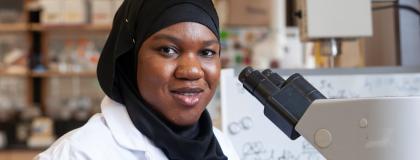
Biological and Medical Physics Co-op Information for Employers
Adding Value to Your Team
This major is an exciting and interdisciplinary science in which biological and medical problems are tackled using the techniques and concepts of physics. Many areas of biological physics have important implications for human health; examples include the probing of molecular structure in muscle by X-ray diffraction and the study of molecular dynamics in cell membranes by nuclear magnetic resonance. Medical physics provides the background for such advanced clinical tools as magnetic resonance imaging (MRI), CAT and PET scans, and many more. Courses in the Biological and Medical Physics major include Biophysics of Excitable Cells, Radioactivity and Radiation, Molecular Biophysics, and Clinical Applications of Physics, providing an excellent education for careers in clinical research and in health services.
University of Guelph Advantage
- An international reputation for excellence in research - grants awarded to faculty have been higher than the national average for over a decade
- Five Physics/Biological & Medical Physics faculty members have been named Fellows of the Royal Society of Canada.
Our co-op process responds to your needs. Employers can post, interview and hire throughout the semester and our students are available for 4 or 8 month work terms. The Experience Guelph hiring tool makes hiring Guelph co-op students easy!
Student Strengths
Knowledge
As students begin the second and third work terms, they have started to specialize in one of a number of biological areas of emphasis such as genetics, microbiology, or toxicology.
Application
By their first work term, students have had 10 lab courses, 3 hours/week per course, as well as a solid foundation in biology, physics, chemistry and mathematics.
Problem Solving
Excellent communication and problem-solving experience.
Understanding
In their final work term, students will have a greater theoretical understanding of physics and biophysics and will be skilled in writing reports and summaries.
Biological and Medical Physics Work Term Schedule
| YEAR | FALL | WINTER | SUMMER |
|---|---|---|---|
| ONE | Academic | Academic | Off |
| TWO | Academic | Academic | Work |
| THREE | Academic | Work | Work |
| FOUR | Academic | Academic | Work |
| FIVE | Work | Academic |
Biological and Medical Physics Course Sequencing
Please see the current undergraduate calendar for more information.
Fall
- Introduction to Molecular And Cellular Biology
- General Chemistry I
- Calculus I
- Physics for Life Sciences
- 1 Liberal Education or Restricted Elective
Winter
- General Chemistry II
- Biological Concepts of Health
- Physics for Life Sciences II
- Linear Algebra I
- Calculus II
Fall
- Applied Differential Equations
- Introduction to Biochemistry
- Structure and Bonding
- Introduction to Co-operative Education
- Introduction to Biological and Medical Physics
- 1 Restricted Elective
Winter
- Structure and spectroscopy
- Experimental Techniques In Physics
- Biophysics of Excitable Cells
- Foundations in Molecular Biology and Genetics
- 1 Restricted Elective
Summer
Work Term One
Fall
- Thermodynamics and Kinetics
- Molecular Biology of the Cell
- Electricity and Magnetism I
- radioactivity and radiation Materials
- 1 Elective
Winter
Work Term Two
Summer
Work Term Three
Fall
- Science Communication
- Quantum Mechanics I
- 3 Electives
Winter
- Structure and Function in Biochemistry
- Clinical Applications of Physics in Medicine
- Intermediate Laboratory
- 2 Electives
- Computational Methods In Materials Science
Summer
Work Term Four
Fall
Work Term Five
Winter
- Molecular Biophysics
- Advanced Physics Laboratory
- 4 Electives
Restricted Electives
1.00 credits (2 courses) of Liberal Education electives are required.
One of: Programming or Introduction to Programming
One of: Advanced calculus or Statistics I
